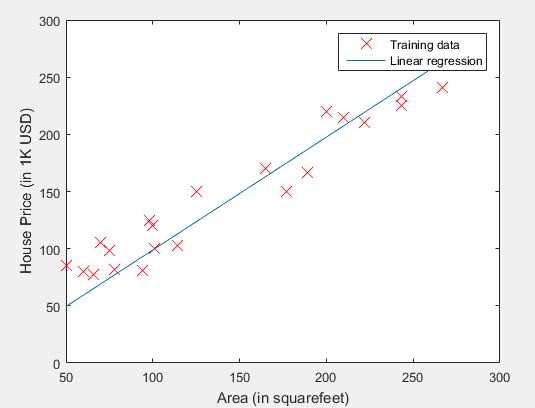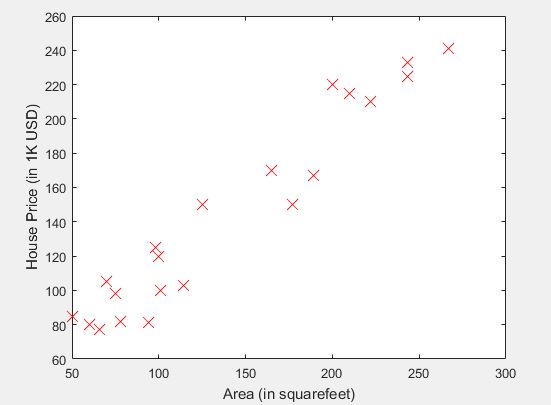Everything starts with simple steps, so does machine learning. This post will talk about regression supervise learning. If you’re not familiar with some term, I suggest you to enroll machine learning class from coursera. The idea is to give prediction regarding current data/training set available, represented in form of linear equation.
For example, let’s see figure below:
Image above describe relation between total area of the house (in squarefeet) and house price (in 1K USD). Let’s say I want to sell my house (112 squarefeet). By using this data, I want to predict how much should I sell my house. The idea is to create model using linear equation that is close enough to form function of above image. For this writing purpose, I will simplify the form of equation to become a vectorized form so that we can easily adapt it into matlab.
First step is to create hypothesis function, defined by linear equation below:
The vectorized form for above equation is:
where is the total area of the house and
. Please note that the intention to put
in the equation is to simplify the form of equation into vectorized form.
Next idea is to minimize some function that has relation between our hypothesis function, and the actual house price. This is a building block of supervised learning algorithm, referred as cost function J, defined as follows:
The vectorized form is:
where is the number of training set data, and
is the actual house price. For any value of
and
, the value of cost function can be vary. Our purpose is to minimize the cost function by doing update to value of
and
in several iterations needed. By deriving equation of cost function relatively to
and
(remember that the cost function J is relatively to
), we got following approach:
The vectorized form is:
where is learning rate. If
is too small, it will need a lot of iteration to come up with the right value of
and
. Meanwhile if
is too big, it can overshoot the minimum and fail to converge. Please note that we need to update the
value simultaneously, and for that purpose I have been derived all of the equation into vectorized form.
The implementation in Matlab is roughly like this
function J = computeCost(X, y, theta)
m = length(y); % number of training examples
%calculate J function by using vectorized
J = sum((transpose(theta) * X - y).^2)/(2*m);
end
function [theta, J_history] = gradientDescent(X, y, theta, alpha, iters)
m = length(y); % number of training examples
J_history = zeros(num_iters, 1);
for iter = 1:iters %for converged function purposes
J_history(iter) = computeCost(X, y, theta);
h = X * theta; %hypothesis function
diff = h - y; %delta between hypothesis function and actual price
%compute the new theta value by executing the derivation equation
theta_change = (diff * transpose(X) .* alpha) /m;
theta = theta - transpose(theta_change);
%make sure cost function J is always decreasing
fprintf('%f %f %f \n', J_history(iter), theta(1), theta(2));
end
end
In this calculation, I use as if I use larger
, it can overshoot the minimum. We can see that the value of cost function J is decreasing until it reach end of iteration. (See line 11 and 12, the difference of cost function J is up to 3 digits after decimal value which is already converged).
12085.976190 0.001446 0.240599 7001.842606 0.002555 0.422608 4092.378664 0.003408 0.560293 2427.398658 0.004068 0.664450 1474.591315 0.004581 0.743243 929.334352 0.004985 0.802847 617.303572 0.005304 0.847937 438.739612 0.005560 0.882047 ... 199.313357 0.094885 0.987497 199.313004 0.094944 0.987496 199.312650 0.095004 0.987496 Theta found by gradient descent: 0.095004 0.987496 For area 112, we predict a price of 110.694545
By above result, the hypothesis function is defined as follow:
The result of linear regression figure can be seen below:

Cheers!
